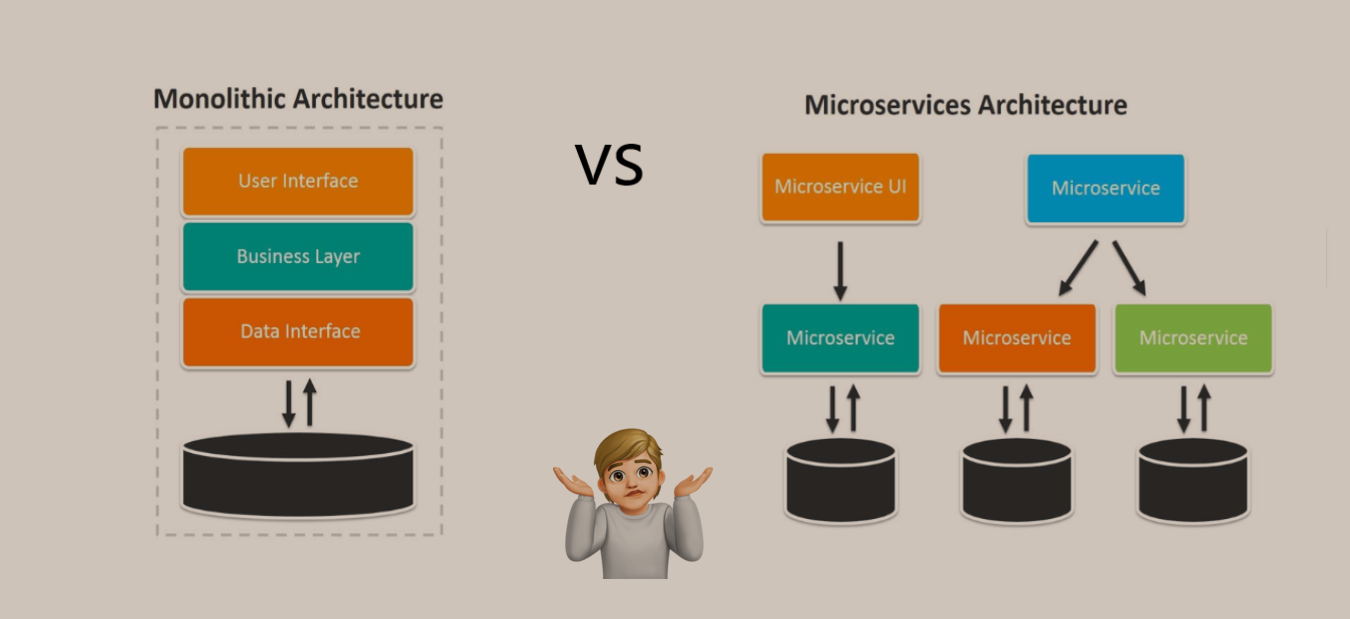Which is Right for You?
The performance, scalability, and agility of your software are affected by the right choice of architecture. Choosing the right architecture for your business can make a significant impact on your development process and scalability even though both approaches have their weaknesses and strengths. Microservices provide more flexible approaches and scalable solutions. But, on the other hand, monolithic architecture offers all-in-one solutions that can be simple and easy to develop and deploy.
So, which is the right choice for you? If you are not sure, we are here for you. In this blog post we’ll explore the differences between these two approaches and help you make an informed decision for your organization’s needs. Let’s dive in!
Monolithic Architecture
Monolithic architecture is a traditional approach to building large applications where the entire application is built as a single, self-contained unit. All components of the application are tightly coupled and run as a single process.
Simplicity is the key benefit of monolithic architecture. All components are running in a single process and there is no need to manage multiple services or worry about inter-service communication. But, on the other hand a large, monolithic application makes development more complex and slower. Let’s see what else monolithic architecture offers us and what it takes away.
Advantages of monolithic architecture:
- Performance – Monolithic applications can be faster because there is no overhead associated with network communication between different components.
- Easy testing – Since all components are coupled, testing can be easier as there are fewer dependencies to manage.
- Seamless debugging – When an app operates as one indivisible unit, it’s easier to follow a request and find an issue.
Disadvantages of a monolithic architecture:
- Scalability – As the application grows, it becomes increasingly difficult to scale individual components. Scaling the entire application requires scaling the entire monolith, which can be difficult.
- Agility – It can be challenging to make changes to the application without affecting other components when all components are coupled.
- Limited fault tolerance – A failure in any component can bring down the entire application.
- Deployment – Monolithic architectures can be challenging to deploy because the entire application needs to be deployed at once. This can make it difficult to roll out new features or updates without causing downtime or disrupting the application.
Microservices architecture
Microservices architecture is a style of software architecture that structures an application as a collection of small, autonomous services that work together to provide the overall functionality of the application. The independent services communicate with each other through APIs. Each service is responsible for a specific business capability and can be developed and deployed independently. Updating, testing, deployment, and scaling occur within each service.
The microservices architecture doesn’t necessarily simplify complexity, but it helps manage complexity by breaking down tasks into smaller, autonomous processes that operate independently and collaborate to provide the overall system functionality. Software updates can be performed more frequently. We can do updates two to three times a day instead of pushing updates once a week.
In addition to the previously mentioned advantages, let’s take a look at what else microservice architecture offers us.
The advantages of microservices architecture include:
- Scalability – Each service can be scaled independently, which makes it easier to handle growth in specific areas of the application.
- Agility – Since each service is independent, it’s easier to make changes to the application without affecting other components and promote agile ways of working with small teams that deploy frequently.
- Fault tolerance – A failure in one service won’t necessarily bring down the entire application.
- Deployment – fast and easy independent deployment of individual features.
While microservices architecture offers many benefits, it can also introduce complexity that leads to uncontrolled growth and sprawl during development. It can be difficult to ascertain the relationships between different components, who is responsible for each software component, or how to avoid interfering with dependent components.
Disadvantages of a microservices architecture:
- Complexity – Since the application is broken down into smaller services, there are more moving parts to manage.
- Performance – Microservices architecture can be slower than monolithic architecture due to the overhead associated with network communication between different components.
- Testing – Testing can be more complex because there are more dependencies to manage.
- Exponential infrastructure costs – Each new microservice can have its own cost for test suite, deployment playbooks, hosting infrastructure, monitoring tools, and more.
Which Architecture is Right for You?
Choosing between microservices and monolithic architecture can be a difficult decision. The right approach depends on your specific needs, goals, and resources.
Choose monolithic architecture if you’re building a small application because it’s simpler to develop and deploy. But if you anticipate significant growth in specific areas of your application, microservices architecture may be the better choice because it allows for easier scalability.
Consider the following in making your decision:
- Development speed: If you need to get your application to market quickly, monolithic architecture may be the better choice because it’s faster to develop.
- Flexibility: If you anticipate needing to make frequent changes to your application, microservices architecture may be the better choice because it’s easier to make changes without affecting other components.
- Resources: Microservices architecture requires more resources to manage than monolithic architecture. Consider whether you have the resources to manage a more complex architecture.
Conclusion
Both microservices and monolithic architecture have their strengths and weaknesses. When choosing between them, consider the specific needs of your application, such as size, scalability, and development speed.



